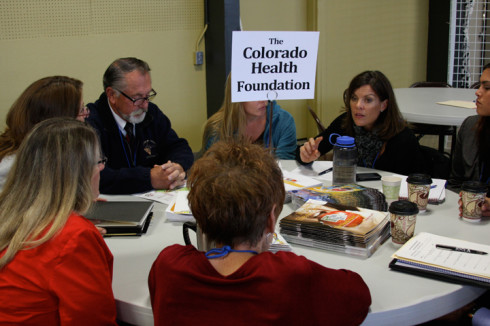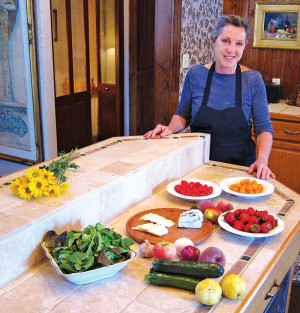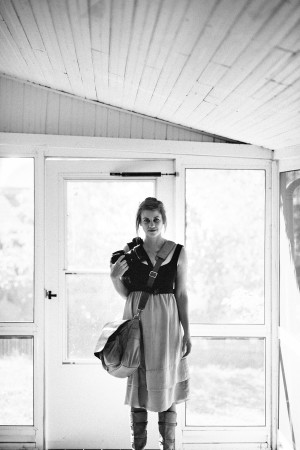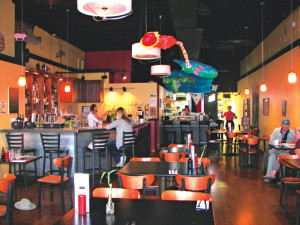By Elliot Jackson
The city of Salida got to do one of the things it does best in September. To welcome a special group of economic developers, it threw a walkabout of its art galleries and local businesses for the 300+ participants of the Heart of the Rockies Region Rural Philanthropy Days (RPD). The walking tour introduced the RPD conference, including representatives of some of Colorado’s largest nonprofit funders, to Salida in its newly-minted status as a Colorado Creative District. The downtown business owners, in their turn, welcomed the after-hours customers.
“This was something different,” according to Brett Haydin, co-chair of the steering committee for the RPD, whose 45 members were drawn from across a five-county region. “We wanted to give the (conference) participants, many of whom were coming from Denver and the Front Range, a sense of what it was like to be in our rural community.”

What factors contribute to the economic health of a rural community? What combination of culture, resources and industries can both lessen the impacts of the “boom” and cushion the “bust” of the traditional rural Colorado economic cycle? It is a truism universally acknowledged, if not universally believed, on the American political scene that Job Creation is the sole provenance of the for-profit world: so the role of governmental, or other nonprofit, organizations in the health and maintenance of a rural community’s economy can be overlooked, misunderstood, or even maligned.
RPD is an event organized to connect the dots between Front Range-based granting agencies, and grant seekers from nonprofit agencies in rural areas around the state. RPD is the brainchild of a collaboration between the Denver-based Community Resource Center (CRC), publisher of the Colorado Grants Guide, and some of the largest Front Range foundations. According to the RPD website, the CRC discovered as it was putting together its first guide that only 3% of the funds granted by Colorado’s private foundations were awarded outside the Front Range. RPD became the bridge to connect the foundations with rural nonprofits, and provide a marketplace for networking, building relationships, and educating each other on needs and service in the region.
There are two RPD events per year, spread out over eight rural regions, so that the Heart of the Rockies region hosts the event every four years. The heart of RPD is what has come to be known as “the round tables”: representatives of nongovernmental granting agencies such as the Anschutz Family Foundation, or government agencies such the Department of Local Affairs (DOLA), sit in conference with groups of participants from rural nonprofits ranging from faith-based food banks to arts and animal welfare groups to county social service departments, discussing their missions and their funding goals.
Each participant at the round table pitches a grant proposal to the funders, who use a “red yellow green” system to rate each proposal. A “green light” means that the funder thinks the proposal is a good fit for the foundation; a “yellow light” means the funder isn’t sure, or would require more information to make a decision; and a “red light” means that funding would be unlikely.
In order to maximize the number of “green lights” for proposals, the funders help to host pre-round table training workshops aimed at helping grant seekers to better understand what the grant funding process is like, how to tell what types of projects individual foundations are looking to fund, and how to craft what participants come to call the “elevator speech”: a condensation of their organization’s mission statement, and proposed grant opportunity, into a forceful two-minute presentation.
While most of the readily-available statistics on the economic impact of nonprofit organizations in Colorado are from 2008 and before, and thus would necessarily offer a rosier funding picture than is currently the case, the impact is still large. According to the Urban Institute’s 2010 study, there are over 28,000 nonprofit organizations registered in Colorado, with 15,611 actively filed with the IRS.
A quick look at Governor Hickenlooper’s campaign website turns up a page devoted to “Nonprofits and Philanthropy” wherein he outlines a plan to increase state assistance to nonprofit and faith-based organizations, in recognition of the role they play in providing information, entertainment and services to the state of Colorado. In good news for arts organizations, which have suffered great cuts in funding in the current economic climate, the Governor mentions them specifically, and “creative industries” generally, as engines of economic development.
As part of the state economic development plan, therefore, Colorado Creative Industries (CCI) was formed from the merger of several state programs on the arts, and charged specifically with the task of “promot(ing), support(ing) and expand(ing) the creative industries to drive Colorado’s economy …” It was the CCI-sponsored Creative District grant competition that Salida won in September; the funding is provided by a unique partnership between the state and the Boettcher Foundation.
As Timothy Schultz, the Executive Director of the Boettcher Foundation explains it, “$25,000 is being allocated over three years, matched dollar-for-dollar by the community, to each of 12 separate districts, to found a funding stream for communities to find a way to fund a “creative district” – whether through a taxing district or other means.” The object is to create a space not unlike Salida’s current downtown “arts district” – think of it as an enterprise zone for artists and art organizations.
“These (creative district programs) are a confirmation of the foundations, and the arts, having a key role to play in economic revitalization,” says Sheila Sears, a program officer with CCI. As a result, “arts and cultural programs are getting new life and being seen as integral to the community.”
Both Schultz and Sears were present at the RPD in Salida, and both, when asked what made this RPD unique for them, were effusive in their praise of the downtown walk, and the sense it gave them of being really introduced to the town. “I loved the focus on buy and eat local,” said Sears, “and it was amazing to see the number of businesses that opened for us.”
Schultz related that he overheard some of the gallery owners expressing their gratification at being able to profit from the nonprofit conference – many of the participants appear to have bought art!
As for participant and Salida resident Andrea Earley-Coen, representing the local nonprofit Guidestone, the roundtables were the best part of RPD for her. “It was a very positive experience, and great to meet the funders.” She paused, and grinned. “We got a lot of green lights!”
Elliot Jackson can say, for the first time ever, that she actually lives *and* works in Salida.




